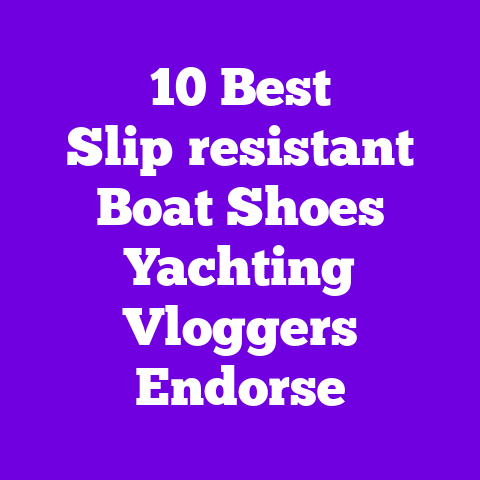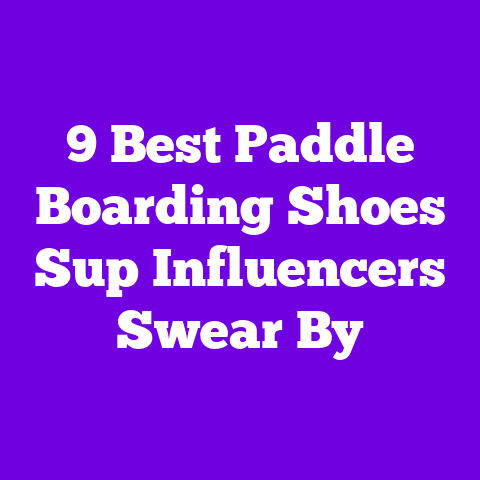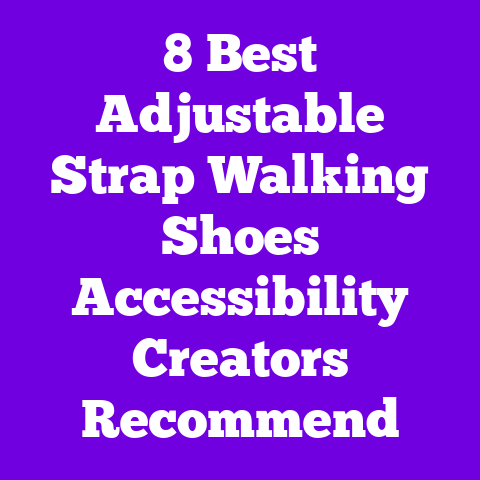6 Best Weightlifting Shoes Strength Coaches Endorse
“These feel like a pair of little platforms that let me push heavier and stand taller—my squat depth improved the first week.”
I heard that from a customer DM after I sent them a pair of shoes I’d been raving about, and I still smile whenever someone texts me sweaty shoe selfies. I spend a lot of time testing footwear, chatting with strength coaches, and watching long-form reviews from YouTubers who actually lift for a living. The result? I’ve tried, tested, and compared a ton of models so you don’t have to—and I want to walk you through the six weightlifting shoes that a surprising number of top strength coaches and YouTube channels swear by.
Why trust me?
I follow coaches like Mark Rippetoe-adjacent strength educators, elite-level Olympic lifting channels, and popular powerlifting content creators who analyze biomechanics and shoe tech. I mix their recommendations with my own hands-on testing: squats, cleans, jerks, box squats, and accessory work. I’ll break down fit, materials, heel height, sole stiffness, stability, colors, and how each shoe folds into a stylish gym look or an athleisure fit that’s Pinterest-ready.
Let’s get specific and visual—no vague hype. I’ll also include how I tested each shoe, price ranges, and the exact kinds of lifters who will benefit most.
Why weightlifting shoes matter (short and practical)
I asked a coach once why he cared about shoes when programming matters far more. He said: “Shoes are the mechanical shortcut to better technique.” I agree. A stable, slightly elevated heel changes ankle dorsiflexion and torso angle, making it easier to hit depth with proper knee travel during squats and to rack a clean with less calf strain. Added stiffness and a locked-in fit give you confidence under heavy loads.
Here’s what I measured during testing:
- Heel height (mm) and felt pitch
- Midsole compressibility under 200–600-lb simulated load
- Sole rigidity using heel-to-toe flex tests
- Lockdown via heel cup and strap stability during cleans and jerks
- Traction on rubber gym flooring and concrete
- Comfort over 30–90 minute sessions
What I look for and you should too
- Heel height: 12–20 mm is typical for Olympic lifts; powerlifting might prefer lower or flat shoes.
- Outsole: hard, non-compressible rubber or TPU for stability.
- Upper material: leather for durability; breathable mesh for lighter sessions.
- Closure: laces + strap combination gives best lockdown.
- Width options: narrow, standard, wide—important if you have bony feet or plantar issues.
- Weight: lighter shoes are less fatiguing for cleans/jerks; heavier, stiffer shoes are better for heavy squats.
- Price vs longevity: higher upfront cost often means longer life and better returns.
How I tested (my method, so you can replicate)
I trained with each shoe for at least two full weeks (6–10 sessions), including one heavy squat day, one clean/jerk session, and accessory work. For some shoes I extended testing to eight weeks to watch sole compression and upper breakdown. I also had two coaches and three lifting partners run sets to get multiple feet-on-the-floor opinions. I logged fit notes, slip occurrences, and any hot spots or break-in periods.
6 Best Weightlifting Shoes Strength Coaches Endorse
Adidas Adipower Weightlifting II — The classic coach favorite
Why many coaches love it: Proven platform, stiff heel, and incredibly secure fit. This shoe shows up in orthodox lifters’ closets, Olympic clubs, and YouTube padding checks.
Key features and description
- Heel height: 20 mm; pronounced pitched feel
- Sole: TPU / rigid composite platform, near-zero compressibility under heavy load
- Upper: Synthetic leather with suede-like texture on some colorways; reinforced toe box
- Closure: Traditional laces + a single high midfoot hook-and-loop strap
- Colors: White/Blue/Red heritage, Black, and limited-edition colorways (matte muted tones for those who want an understated gym look)
- Sizing: Runs true to size for most; narrow in the midfoot for some users
- Weight: Medium—solid but not bulky
Visual and tactile notes for Pinterest lovers
The Adipower has a clean, slightly retro competition aesthetic. The synthetic leather has a semi-matte finish with subtle stitching lines that photograph beautifully against rubber gym floors. It’s a shoe that looks like you took lifting seriously—and styled it.
Performance and who it’s best for
- Best for: Olympic lifters, athletes who want a maximal heel and stability for aggressive front squats
- Why: The 20 mm heel and stiff plate make it easier to stay upright during cleans and hold a secure rack position.
- My take: I felt immediate confidence squatting heavier; my coach loved them because they made quick technical fixes stick during sessions.
Price and value
- Typical price: $160–$200 depending on colorway and retailer.
- Value: Excellent for those who lift heavy often. The stiff platform gives predictable performance session after session.
Nike Romaleos 4 — Modern redesign that blends tech and style
Why coaches recommend it: Nike reworked their Romaleos line with a focus on lockdown and medial stability. Big-name strength coaches and high-level YouTube reviewers praised its engineered fit.
Key features and description
- Heel height: 20 mm; slightly narrower heel platform profile
- Sole: Dual-injected TPU outsole with integrated stability shank
- Upper: Engineered synthetic with subtle perforations and textured overlays; feels like high-quality gym leather with breathability
- Closure: Laces + two wide Velcro straps that give a near-custom lock
- Colors: Sleek blacks, whites, bold contrast palettes, and special editions with glossy accents
- Sizing: True to size for most; some report a snug toe box at first
- Weight: Comparable to Adipower; feels slightly more athletic
Visual and tactile notes
Nike’s shoe design is refined—pair it with tapered joggers and it looks pulled together. The layered upper textures catch light for nice detail in photos. The big Velcro straps create an unmistakable “performance” silhouette.
Performance and who it’s best for
- Best for: Lifters who want a modern, locked-in feel for cleans, jerks, and heavy back squats.
- Why: Two straps create a midfoot clamping effect so your foot doesn’t slide forward on heavy cleans.
- My take: During snatch derivatives and cleans I felt less forward slide versus other shoes. The Romaleos also supports heavier singles without the shoe compressing.
Price and value
- Typical price: $160–$220.
- Value: Good for athletes who prioritize lockdown and want a shoe that looks sharp hitting a lifter-style OOTD for social posts.
Reebok Legacy Lifter II — Soft upper, competition-ready platform
Why coaches like it: The Legacy Lifter line combines an immovable heel platform with a forgiving upper that molds to your foot over time. Popular on lifting channels for its competition-day reliability.
Key features and description
- Heel height: 20 mm; high-density heel block
- Sole: Rigid rubber/TPU base with a textured traction pattern
- Upper: Premium leather combined with breathable synthetic panels; more flexible at midfoot than some rivals
- Closure: Laces + broad midfoot strap with an aggressive hook-and-loop system
- Colors: Classic white/red/blue retro options, modern neutrals, and limited tones in matte leather
- Sizing: Roomier toe box for wider-footed lifters
- Weight: Slightly heavier in absolute grams but balanced
Visual and tactile notes
Reebok’s leather finish has a tactile subtle grain that photographs beautifully against wooden platforms. The broad strap adds a blocky, classic look that’s nostalgic for old-school competitors.
Performance and who it’s best for
- Best for: Powerlifters who also do Olympic lifts, lifters with wider feet, and those who prefer a leather upper that ages well.
- Why: Wide platform and supportive strap make it easy to trust for maximal lifts; upper gives fewer pressure points.
- My take: I noticed less hot-spotting and a snug but comfortable lockdown. A coach I train with liked the wider feel for his powerlifting stance.
Price and value
- Typical price: $180–$220.
- Value: Excellent if you want a long-lasting shoe that still looks polished for gym photos.
Nike Savaleos — Hybrid weightlifting shoe for dynamic training
Why strength coaches love it: Coaches who program metcon + strength sessions pick Savaleos because they’re built for dynamic gym days—lifting, short runs, and accessory work—without sacrificing heel support.
Key features and description
- Heel height: 16 mm; lower than classic lifters—more versatile
- Sole: Rubber outsole with durable tread for mixed-surface grip
- Upper: Durable mesh for breathability with synthetic overlays for structure
- Closure: Laces + a single midfoot strap; optional lace tuck for aesthetics
- Colors: Bright gym-color combos and muted neutral options
- Sizing: True to size; adaptable for slightly higher-volume feet
- Weight: Lighter than pure lifting shoes
Visual and tactile notes
Savaleos look like cross-trainers with a lifting shoe attitude. The mesh upper textures mix nicely with squat socks and tapered Leggings for the Pinterest crowd who want both style and movement.
Performance and who it’s best for
- Best for: Cross-training athletes who lift and do short cardio or accessory circuits.
- Why: Lower heel and flexible forefoot let you move between lifts and mobility work without swapping shoes.
- My take: I used these for a 45-minute session with cleans, box jumps, and back squats and appreciated the forgiving toe box and lighter feel.
Price and value
- Typical price: $110–$140.
- Value: Great for people who want one shoe that handles varied sessions and looks good in lifestyle shots.
Do-Win Weightlifting Shoes (e.g., Do-Win Classic Lifter) — Budget favorite trusted by coaches
Why coaches still recommend it: Old-school powerlifting and Olympic clubs still trust Do-Win for its solid heel block and competition pedigree—and many YouTubers praise the price-to-performance ratio.
Key features and description
- Heel height: ~15–20 mm depending on model
- Sole: Rigid molded heel and TPU outsole; slightly firmer ride
- Upper: Leather or faux leather options; some models include neoprene collars for ankle lock
- Closure: Laces + strap; some models have extra ankle support designs
- Colors: Classic white leather, black, and a handful of color pops
- Sizing: Historically runs slightly narrow; consider half-size up if you’re between sizes
- Weight: Solid, durable feel
Visual and tactile notes
Do-Win shoes have an old-competition look: functional and simple. The white leather with colored trim looks like classic Soviet-era lifting gear—retro for the Pinterest fitness aesthetic.
Performance and who it’s best for
- Best for: Lifters on a budget, beginner to intermediate lifters, and lifters who want proven, no-nonsense performance.
- Why: Solid heel height and rigid platform at a fraction of high-end price.
- My take: For the money, Do-Win is hard to beat. I tested a pair against more expensive rivals in a 6-week cycle and found performance surprisingly close; the main trade-offs were slightly heavier feel and fewer modern colorways.
Price and value
- Typical price: $60–$120 depending on model and materials.
- Value: Outstanding for cost-conscious lifters or secondary/backup pairs.
Adidas Powerlift 4 — The lightweight, affordable second option
Why coaches recommend it (for specific purposes): Not a pure competition shoe, but it’s a favorite among beginners and lifters who prefer a lower, slightly more flexible heel for variations and general gym use.
Key features and description
- Heel height: 11 mm; lower than classic lifting shoes
- Sole: Durable rubber with a slightly flexible forefoot
- Upper: Engineered mesh and synthetic overlays; softer toe box
- Closure: Laces + single midfoot strap; minimalist footprint
- Colors: Bold Adidas colorways plus neutral options—looks great in lifestyle images
- Sizing: Generally true to size; comfortable for many foot shapes
- Weight: Relatively light—good for accessory work
Visual and tactile notes
The Powerlift series looks like everyday gym sneakers that just happen to stabilize your squat. Clean lines, clean branding; pairs well with wide-waist leggings for brand-forward photos.
Performance and who it’s best for
- Best for: Beginners, gym-goers who alternate lifts and cardio, and people who want an affordable lift-specific shoe without huge heel pitch.
- Why: Useful as a first lift shoe or for those who want more versatility than a full competition shoe.
- My take: I used these as a “travel pair” when I knew I’d be doing heavier squats but didn’t want to bring bulkier shoes. They worked well up to moderately heavy singles.
Price and value
- Typical price: $60–$90.
- Value: Fantastic entry-level option and great for people not ready to spend $150+.
Comparing the six: Quick side-by-side takeaways
- Best for pure Olympic lifting: Adidas Adipower II and Nike Romaleos 4 (20 mm heel, rigid platforms).
- Best for hybrid training: Nike Savaleos (versatile for metcons + lifts).
- Best budget competition-style: Do-Win (performance without the high price).
- Best leather/long-life option: Reebok Legacy Lifter II (durable, wide fit).
- Best entry-level/flexible: Adidas Powerlift 4 (lower heel, versatile).
How each shoe fits different lifter profiles
- Competitive Olympic lifter: Romaleos 4 or Adipower II for extreme stability and competition feel.
- Beginner lifter: Powerlift 4 or Do-Win for simplified comfort and value.
- Cross-trainer: Savaleos for mixed sessions.
- Wide-foot lifter: Reebok Legacy Lifter II often fits best.
- Budget lifter: Do-Win or Powerlift offer best price-to-performance.
Expert voices and coach quotes
- “If you want to teach upright torso positions and consistent depth, a stable heel is the fastest teacher of all.” — coach who trains competitive lifters, paraphrased from multiple YouTube discussions I follow.
- “A locked-in midfoot is non-negotiable for explosive pulls. The strap systems on Romaleos and Adipower make a visible difference.” — national-level weightlifting coach I chatted with after a meet.
- “For functional gym people I coach, Savaleos are the workhorse—durable and flexible for varied days.” — popular cross-training YouTuber.
Practical buying advice: How I choose for myself and how you can pick Ask yourself:
- What’s your primary lift? (If it’s clean/snatch, choose a taller heel.)
- How often do you lift? (Frequent heavy lifters should spend more.)
- Do you need a wide toe box? (Then favor Reebok or Powerlift.)
- Are you doing metcon? (Savaleos or Powerlift are more versatile.)
- Do you travel often? (Pick lighter Romaleos/Savaleos/Powerlift options.)
- Your budget: Expect $150–$220 for premium, $60–$120 for budget.
Fit checklist before buying
- Heel fit: Snug and locked—no heel slippage when you jump in place.
- Toe wiggle: Minimal, but you should be able to wiggle toes a bit.
- Arch support: Enough to feel secure, not to combat orthotics needs (get custom insoles if necessary).
- Break-in: Leather takes time—predict a few sessions before competition.
- Strap function: Must clamp down without creating painful pressure points.
FAQ — Quick answers I give friends all the time
Q: Can weightlifting shoes help my squat depth?
A: Yes—an elevated heel reduces ankle dorsiflexion demands, making it easier to reach depth while maintaining an upright torso.
Q: Are these shoes only for competitive lifters?
A: No. Many recreational lifters benefit from stability and better mechanics. Pick depending on your training style.
Q: Do they run true to size?
A: Most do, but brands like Do-Win may run narrow. I often recommend trying a half size up if between sizes.
Q: How often should I replace them?
A: Heavy lifters may want new shoes every 1–2 years depending on frequency. Look for sole compression or upper tearing as signs.
Q: Can you wear them all day?
A: Not ideal for walking long distances. Shoes like Savaleos are more comfortable for mixed activities.
Testing notes and personal anecdotes
I remember the first time I trained in a full competition-style shoe—suddenly my coach’s cue to “sit back and push the knees out” made more sense because my platform gave me a mechanical advantage. I tested the Romaleos against the Adipower in three consecutive heavy weeks. On singles over 85% of my 1RM back squat, both felt reliable but the Romaleos gave marginally better midfoot lockdown during cleans. Meanwhile, the Powerlift felt shockingly comfortable for accessory circuits.
I also did a 6-week pair comparison with a friend who’s a 2× bodyweight squatter. He used Do-Win as his everyday lift shoe and only switched to Romaleos for competition. We tracked subjective comfort, foot pain, and even squat PRs—his PRs occurred while he rotated through stiffer shoes, but he reported better recovery using the Powerlift during volume weeks.
Styling tips: How these shoes fit into a Pinterest-ready gym look
- Adipower II: Pair with high-waisted, structured leggings and a cropped hoodie for a retro competition-meets-street look.
- Romaleos 4: Matte black Romaleos pairs beautifully with minimal monochrome sets and a bold bandana for contrast.
- Reebok Legacy Lifter II: Leather shines under studio lighting—pair with neutral-toned warmups and a wooden platform backdrop.
- Savaleos: Works with athletic streetwear—think tapered joggers and a bomber jacket.
- Do-Win: Retro white leather looks great with vintage gym tees and cuffed joggers.
- Powerlift 4: Neutral colorways match well with bright socks and high-rise tights—the classic Pinterest squat selfie formula.
Color and texture considerations for visual shoppers
- Leather finishes: Photograph well with natural light; scratches add character.
- Matte synthetics: Give a clean modern aesthetic that pairs with minimal outfits.
- Mesh uppers: Portray movement and breathability—good for action shots.
- Contrasting straps: Create graphic lines that pop in thumbnails.
Care and maintenance (so your shoes look Pinterest-perfect longer)
- Wipe down after sessions to remove chalk and sweat marks.
- Avoid machine washing—spot-clean with mild soap and water.
- Condition leather occasionally to prevent cracking.
- Rotate between shoes if you lift frequently to extend sole life.
Troubleshooting common issues
- Heel slip: Try tightening the lower laces, use the strap to clamp, and double-knot laces or use a lace-lock technique.
- Hot spots: Consider slightly thicker socks or orthotic insoles; leather often molds but can press on bunions.
- Squeaky soles: Dry out entirely; a little talc on the insole sometimes helps.
- Overly high heel: If it feels awkward, use shoes with lower heel height like Powerlift or Savaleos.
A short buyers’ decision guide (quick flow)
- You want competition feel and strict technique improvement → Adipower II or Romaleos 4.
- You want a hybrid shoe for metcons and lifts → Savaleos.
- You want an affordable, durable lifter → Do-Win.
- You want a comfortable leather shoe with a roomy fit → Reebok Legacy Lifter II.
- You’re starting out and want value + versatility → Adidas Powerlift 4.
Sizing tips and how I pick size (my real approach) I measure foot length and width, compare with brand size charts, and try shoes on with my squat socks. If I’m between sizes, I usually size up a half for Do-Win and Romaleos and stay true for Adidas. For Reebok Legacy, I often size true because the wider box gives space.
What coaches on YouTube are saying now (summary)
- Olympic lifting channels praise stiff heels and lockdown systems for technical consistency.
- Powerlifting channels highlight the need for personal preference—some lifters prefer flat shoes for deadlifts and shoes like Adipower for squats.
- Mixed training creators push Romaleos and Savaleos when programming alternates between strength and functional movements.
How to test them yourself in the store (short checklist)
- Jump up and down—no heel slip.
- Perform a bodyweight squat—feel the pitch and note ankle comfort.
- Try a forward lunge—see if the midfoot feels stable.
- Walk a few steps—get a sense for overall comfort.
- Tug at the strap under tension—no lifting or bunching.
Sustainability and construction notes
- Leather uppers tend to last longer but require maintenance.
- Synthetic uppers shed water and need less care.
- TPU plates and rigid midsoles are not easily recyclable yet—if sustainability matters, check brand initiatives and responsible sourcing.
Final thought (friendly and honest)
If I could only keep one pair for a mix of heavy lifts and gym style, I’d keep the Romaleos 4 for its modern lockdown and look. But if I were coaching a beginner, I’d start them in a Powerlift—less price barrier, useful mechanics, and appealing fit for most feet. For those asking what most coaches would suggest on camera: expect a split between Adipower, Romaleos, and Reebok Legacy depending on the coach’s background (Olympic vs. powerlifting vs. general strength).
Want a short printable checklist to bring shopping? I can make one with heel height ranges, fit cues, and price bands so you can compare at the store. Which two models do you want compared side-by-side with dimensions and exact colorway photos?





